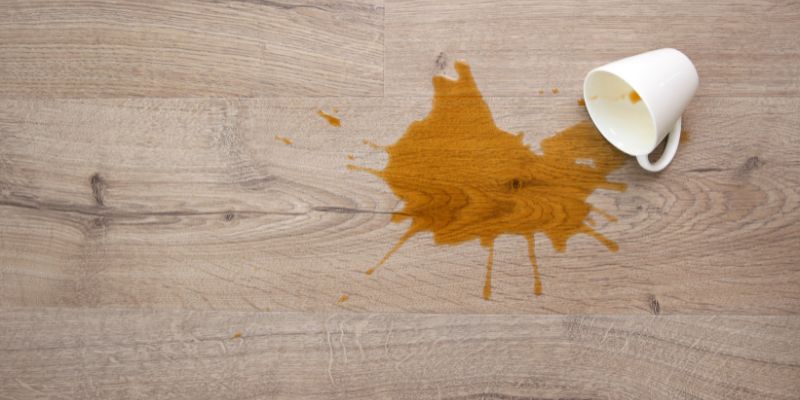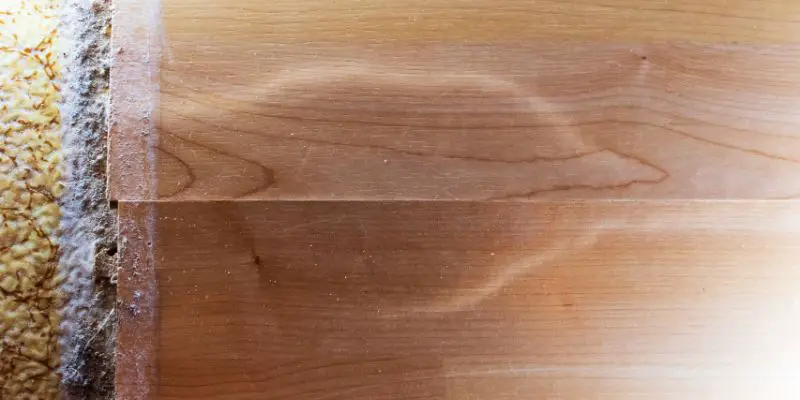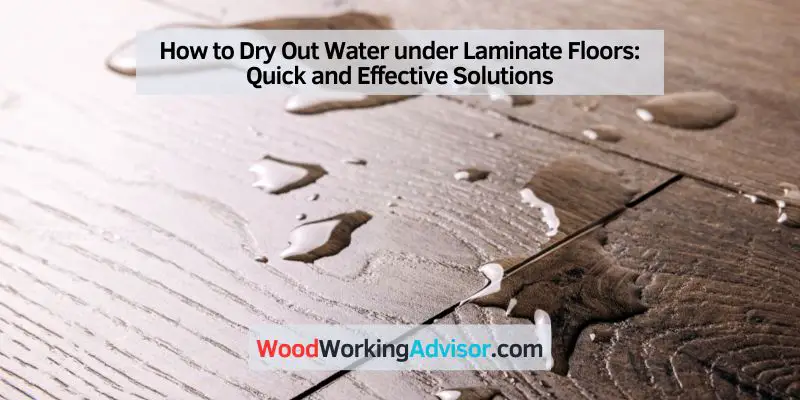To dry out water under laminate floors, use a dehumidifier or fans to increase ventilation and reduce moisture. Laminate floors can add beauty and durability to any space.
However, if water seeps beneath the surface, it can cause warping and damage. Whether it’s from a spill, a leaking pipe, or a flood, it’s crucial to act fast to prevent further harm. In this guide, we will discuss effective methods to dry out water under laminate floors.
By following these steps, you can salvage your flooring and restore your space to its original condition. So, let’s dive in and learn how to deal with this pesky issue efficiently.

Expertise The Cause Of Water Under Laminate Floors
Water under laminate floors can cause serious damage if not addressed promptly. Understanding the underlying cause and taking steps to dry out the water is crucial to prevent mold growth and structural issues. Follow these effective methods to dry out water under laminate floors and keep your home safe and dry.
Identifying Common Sources Of Water Damage
Water damage can occur under laminate floors due to various sources. Identifying these sources is crucial to effectively address the problem. Here are some common sources:
- Leaking pipes: Faulty plumbing systems or leaking pipes can lead to water seeping beneath the laminate floors.
- Appliance malfunctions: A malfunctioning dishwasher, washing machine, or refrigerator can cause water leakage, leading to moisture accumulation under laminate floors.
- Foundation cracks: If your home’s foundation has cracks or gaps, water can seep in from the ground and accumulate beneath the laminate floors.
- Roof leaks: Damaged roof shingles or improper insulation can result in water leaks, which can eventually find their way to the flooring.
The Potential Consequences Of Water Infiltration
When water infiltrates laminate floors, it can lead to various detrimental consequences that should be addressed promptly. Some potential consequences include:
- Warped or buckled floors: Water exposure can cause the laminate flooring to warp or buckle, resulting in a compromised appearance and potential tripping hazards.
- Mold and mildew growth: Moisture trapped beneath the laminate floors creates an ideal environment for mold and mildew to thrive, posing health risks and emitting unpleasant odors.
- Structural damage: Prolonged water infiltration can damage the underlying subfloor and weaken the structural integrity of the flooring system.
- Deterioration of adhesive: Excessive moisture can cause the adhesive used to install the laminate flooring to weaken, leading to loose or separated floorboards.
Understanding the cause of water under laminate floors is essential to effectively address the issue. By identifying common sources of water damage and knowing the potential consequences, you can take the necessary steps to prevent or resolve the problem, ensuring the longevity and aesthetics of your laminate flooring.
Quick Fixes For Drying Out Water Under Laminate Floors
Facing a water issue under your laminate floors can be a stressful experience. Not only can it cause damage to your flooring, but it can also create a breeding ground for mold and mildew. It’s crucial to address this problem as quickly as possible to prevent further damage and potential health hazards. In this blog post, we’ll explore some quick fixes to help you dry out water under laminate floors.
Removing Excess Surface Water
When you notice water pooling on your laminate floor, it’s important to act fast and remove as much of the excess water as possible. Start by using a mop or a wet-dry vacuum to soak up the water from the surface. Be gentle when applying pressure to avoid pushing the water further into the floor.
If the water has seeped into the joints between the laminate planks, you may need to use a small brush or sponge to carefully absorb any remaining moisture. Be sure to dry the area thoroughly to prevent further water damage.
Using Dehumidifiers And Fans
Dehumidifiers and fans can be highly effective in drying out water under laminate floors. Place a dehumidifier in the affected area to remove excess moisture from the air. This will help accelerate the drying process.
Add additional airflow by strategically placing fans around the room. Point the fans towards the wet area to help circulate the air and promote evaporation. Remember to keep the windows and doors open to improve ventilation.
Using Towels Or Absorbent Materials
Towels and absorbent materials are handy tools when it comes to soaking up water from laminate floors. Start by placing clean, dry towels over the wet area, pressing gently to absorb the moisture. Once saturated, replace the wet towels with dry ones to continue the drying process.
If towels are not readily available, you can use other absorbent materials such as clean rags or even paper towels. The key is to remove as much moisture as possible to prevent further water damage.
Applying A Moisture Barrier
After successfully drying out the water, it’s essential to take preventive measures to avoid future water damage to your laminate floors. Applying a moisture barrier can help create a protective layer between your floors and any potential water sources, such as spills or leaks.
You can use a waterproof sealant or a specialized moisture barrier product that is designed specifically for laminate flooring. Follow the manufacturer’s instructions carefully to ensure proper application and maximum effectiveness.
By following these quick fixes, you can effectively dry out water under laminate floors and minimize the risk of damage and mold growth. Remember to address the issue promptly and take preventive measures to keep your floors in optimal condition.

Effective Long-term Solutions For Preventing Water Damage
When it comes to laminate floors, prevention is always better than cure. By taking proactive measures, you can avoid the hassle and expense of repairing water damage under your laminate flooring. Here are some effective long-term solutions to prevent water damage:
Addressing Underlying Plumbing Or Drainage Issues
One of the first steps in preventing water damage under laminate floors is to address any underlying plumbing or drainage issues. Leaky pipes, faulty fittings, or poor drainage can lead to water seeping through and damaging the flooring. If you notice any signs of water damage or suspect a plumbing issue, it’s crucial to seek professional help immediately. Early detection and repair of plumbing problems can prevent extensive damage to your laminate floors.
Sealing Gaps And Cracks In The Flooring
Gaps and cracks in your laminate flooring can provide an entry point for water to seep through. Regularly inspect your floors for any signs of damage or wear and promptly seal any gaps or cracks you find. The market offers a variety of sealants specifically designed for laminate floors. Applying a sealant not only prevents water damage but also prolongs the lifespan of your flooring.
Regular Inspections And Maintenance
Regular inspections and maintenance play a crucial role in preventing water damage under laminate floors. Create a maintenance schedule that includes periodic checks for leaks, cracks, or signs of moisture. Pay close attention to areas near sinks, toilets, or appliances that could pose a higher risk of water-related issues. Undertake swift repairs or replacements as soon as you notice any issues during your inspections.
Educating Yourself On Laminate Floor Care
Equipping yourself with knowledge on laminate floor care can go a long way in preventing water damage. Follow manufacturer guidelines for cleaning and maintenance, ensuring you use the right products and techniques. Avoid using excessive amounts of water during cleaning, as this can seep into the laminate layers and cause damage. Additionally, consider investing in floor mats or rugs in high-risk areas, such as entryways or kitchen sinks, to provide an extra layer of protection against water damage.
Conclusion
To successfully dry out water under laminate floors, it is essential to act quickly and follow the proper steps. By removing excess moisture, using fans or dehumidifiers, and addressing any underlying issues, you can prevent further damage and restore your flooring to its original condition.
Remember, taking immediate action and implementing proper drying techniques is crucial to minimizing the risk of mold or structural issues. So, don’t wait; tackle the problem head-on and save your floors from potential damage.


